Corpus callosum
From Psy3241
| Line 7: | Line 7: | ||
[[Image:Col.gif]] | [[Image:Col.gif]] | ||
| + | |||
| + | ---- | ||
| + | |||
| + | == Development == | ||
| + | In a healthy infant’s brain, the corpus callosum develops between 12 to 16 weeks after conception. The fibers of the corpus callosum continue to become more and more effective into adolescence. By the time a child is around the age of 12 years, the corpus callosum functions will in adulthood, allowing rapid interaction between the two sides of the brain. From this age on the corpus callosum becomes increasingly functional in their typically developing children. | ||
---- | ---- | ||
== References == | == References == | ||
Revision as of 19:34, 21 April 2008
The corpus callosum (Latin for “tough body”) is a broad, thick bundle of nerve fibers in the entire nervous system, running from side to side and consisting of millions and millions of nerve fibers. If we cut a brain in half down the middle, we would also cut through the fibers of the corpus callosum.
If we cut a brain in half down the middle, we would also cut through the fibers of the corpus callosum. When looking at the middle side of one half of the brain, in magnetic resonance imaging (MRI), the corpus callosum looks like a section of a mushroom cap located at the center of the brain.
Development
In a healthy infant’s brain, the corpus callosum develops between 12 to 16 weeks after conception. The fibers of the corpus callosum continue to become more and more effective into adolescence. By the time a child is around the age of 12 years, the corpus callosum functions will in adulthood, allowing rapid interaction between the two sides of the brain. From this age on the corpus callosum becomes increasingly functional in their typically developing children.
References
Hubel, D. H (2006). THE CORPUS CALLOSUM. Retrieved April 21, 2008, from Eye, Brain, and Vision Web site: http://hubel.med.harvard.edu/b34.htm
NODCC, (2006). What is the Corpus Callosum? . Retrieved April 21, 2008, from National Organization for Disorders in the CorpusCallosum Web site: http://www.nodcc.org/what_is_the_corpus_callosum.php

